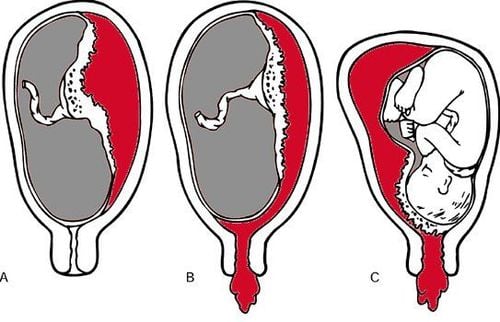This is an automatically translated article.
The article was professionally consulted by Doctor Head of Obstetrics and Gynecology Department, Vinmec Hai Phong International General Hospital.
Excess amniotic fluid is the accumulation of excess amniotic fluid beyond the normal level. Amniotic fluid plays an extremely important role for the development of the fetus, but excess amniotic fluid can have some potential risks and affect the mother and fetus.
1. What is amniotic fluid?
Polyhydramnios is an excess accumulation of amniotic fluid. Amniotic fluid is the fluid that surrounds the fetus after the first few weeks of pregnancy. During most of pregnancy, amniotic fluid is derived almost entirely from the fetus, helps to protect the fetus from injury in the womb, has antibacterial properties thus protecting the fetus from infection. It also helps in lung development. Amniotic fluid also plays a special role as an environment containing fluids and nutrients for the fetus, supporting the fetus to maintain a stable and appropriate body temperature. This amount of fluid will gradually increase until about 1 liter at 37 weeks. After that, the amount of amniotic fluid usually drops to about 0.5 liters by 40 weeks of pregnancy. The baby will regularly swallow amniotic fluid, which then passes out of the body as urine. This is the body's way of controlling the amount of amniotic fluid around the fetus. Once this balance is disturbed, the volume of amniotic fluid can increase rapidly, making pregnant women feel heavy and uncomfortable. To diagnose excess, the doctor will perform an ultrasound and obtain an indirect estimate of the amniotic fluid volume. Mother was diagnosed with amniotic fluid index (A.F.I: amniotic fluid index) through ultrasound from 12-25cm. Polyhydramnios is more than 25 cm.
2. Causes of excess amniotic fluid
Hyperhydramnios is a high-risk pregnancy for women about the cause of excess amniotic fluid and warns of the risk of preterm birth during pregnancy. Due to overproduction of amniotic fluid or due to impaired reabsorption of amniotic fluid. There are maternal, fetal and placental causes.
Maternal causes Diabetes before or during pregnancy is a common cause. Anti-Rh antibodies and hemolytic diseases secondary to abnormal antibodies can cause severe fetal anemia or fetal edema associated with polyhydramnios. Hypertonic dystrophy (uncommon). Causes of placenta Chorionic angioma can cause fetal heart failure and lead to polyhydramnios. Diseases that cause endometritis or placental damage (syphilis) Fetal etiology Fetal central nervous system abnormalities (cerebrovascular, neural tube defects). Structural defects of the digestive system (obstruction of the esophageal or alimentary canal). Fetal chromosomal abnormalities. Non-immune edema: Has a very poor prognosis and is often associated with polyhydramnios. A typical case of placental edema. Twin-to-twin transfusion syndrome: A disorder with a poor prognosis, occurring with an incidence of 15% in monochorionic, biamniotic twin pregnancies, is a complication of polyhydramnios in the recipient fetus.
3. Excess amniotic fluid affects pregnant women and fetuses?

The earlier amniotic fluid occurs in pregnancy and the higher the amount of amniotic fluid, the greater the risk of complications. Premature amniotic fluid affects both mother and baby as follows:
Premature rupture of membranes. Too much fluid in the uterus puts the mother at risk of premature rupture of membranes. Vaginal delivery or other unfavorable situations for the mother Placental abruption Prolapse of the umbilical cord The growth and development of the fetus is restricted, and there is problems with skeletal development To be safe, a mother needs a cesarean section and therefore carries additional risks compared to a vaginal birth, which may include postpartum infections. Excess amniotic fluid can lead to premature birth. The baby is born prematurely, so the organ functions are not perfect, maybe the mother will be given steroids to help the baby's lungs mature faster. Mothers with polyhydramnios are more likely to experience bleeding or spotting after giving birth. This is because the uterus is compressed due to the large amount of amniotic fluid and cannot fully contract as usual. Excess amniotic fluid is the most dangerous for the fetus as it can lead to stillbirth, which is the worst case scenario. Pregnant women need to regularly visit for monitoring, even hospitalization and immediate intervention when necessary when symptoms appear such as shortness of breath, chest tightness; Abdominal enlargement rapidly and markedly, sudden pain.
Vinmec International General Hospital offers a Package Maternity Care Program for pregnant women right from the first months of pregnancy with a full range of antenatal care visits, periodical 3D and 4D ultrasounds and routine tests to ensure that the mother is healthy and the fetus is developing comprehensively. Pregnant women will be consulted and checked for health under the close supervision of experienced and specialized obstetricians, helping mothers gain more knowledge to protect their health during pregnancy as well as minimize complications affecting mother and child.
Please dial HOTLINE for more information or register for an appointment HERE. Download MyVinmec app to make appointments faster and to manage your bookings easily.













